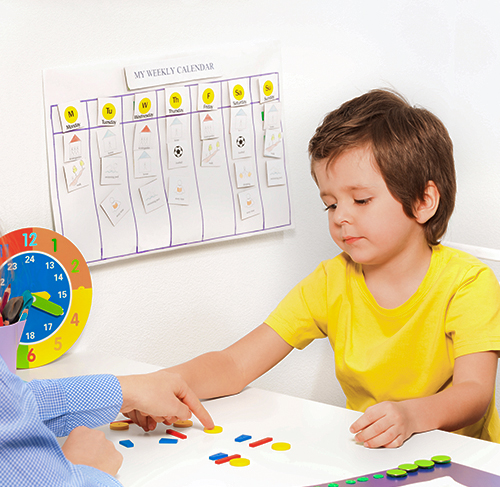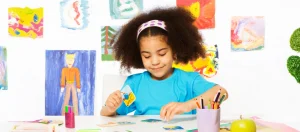Play provides a natural context for young children to learn, grow, and flourish. It provides a basis for proper development including social-emotional abilities, motor skills, cognition, and communication. If a child’s symbolic play skills are not progressing appropriately, this could possibly be a sign of delayed language growth. Symbolic play typically starts to emerge around 12-13 months (Gowan, 1995) and continues to develop throughout the early years. This form of play is the ability to use objects to represent other items. For example, a child demonstrates knowledge of symbolic play by substituting a ball for an apple and pretending to eat the ball.
Why Play Supports Language Development
Play is more than fun. It builds the foundation for learning. Research shows that play strengthens brain connections linked to memory, problem-solving, and communication. When children play, they practice new words in real-life contexts.
Symbolic play, pretend stories, and role-play all give children a chance to use and understand language. These moments improve vocabulary, grammar, and social skills. Studies have also found that play reduces stress, which makes it easier for children to focus and learn.
Types of Play and Their Impact on Language
Different forms of play support speech growth in unique ways.
- Functional play – Using toys the right way, like rolling a car or stacking blocks. This builds understanding of action words and object names.
- Parallel play – Playing side by side with others. Even without direct interaction, children listen, copy words, and start to model speech.
- Cooperative play – Playing together with shared goals. This requires conversation, turn-taking, and problem-solving with words.
- Imaginative play – Pretending to be someone else or creating stories. This expands expressive language, storytelling, and complex sentences.
A mix of these play styles helps children grow their communication skills in natural and fun ways.
Improving Language Through Play
To target symbolic play, you may need to work on functional play first if your child has not acquired these skills by this stage. You can tackle this area by showing your child how to interact with toys in appropriate ways. Do this by demonstrating how to use blocks to build a tower, push a car to make it go, or use a wand to blow bubbles. These are just a few examples.
You can improve symbolic play skills by encouraging your child to be inventive. Model silly and flexible ways of interacting with a toy during play like using a box to represent a car or utilizing a crayon to embody a fire hose. Help your child make up a pretend story to sequence what is happening during play. As you consistently engage your child in play, your child’s language skills will grow and progress.


Play can also be used to help your child process and use language in the following ways:
1. Increase Language Comprehension
- a) Instruct your child to show you specific toys in the following ways: show me the car, point to the boat, or touch the dinosaur.
- b) Once your child’s vocabulary improves, prompt him to point to items based on the manner that they are used. Say things like, “show me something you can throw”, “point to something you drink”, and “touch something you can read”.
2. Increase Language Use
- a) Ask your child questions like “what’s that?” to elicit the name of each toy. Another method you can use is a simple “fill-in” strategy. Say “look this is a ___” and wait for your child to finish the sentence by adding the name of the toy.
- b) Once your child’s vocabulary grows, help your child explain the function of objects by asking questions like what do you do with a cup? what is a key used for? what is a ball used for?
Developmental Milestones for Play and Language
Knowing what to expect at each stage can help parents and caregivers understand progress and spot potential concerns early.
- 12–18 months: Begins simple pretend actions (feeding a doll, pretending to drink). Uses 5–20 words.
- 18–24 months: Expands pretend play to include simple storylines. Vocabulary grows to 50+ words.
- 2–3 years: Combines objects and actions in more complex pretend scenarios. Begins using short sentences.
- 3–4 years: Acts out detailed stories with multiple roles and sequences. Uses more complex grammar.
If a child is not showing these skills within the typical range, it may be worth discussing with a speech-language pathologist or pediatrician.

Play and Bilingual Language Development
Play is a powerful tool for children learning more than one language. Pretend games, songs, and role-play can be done in both languages. For example, a child may pretend to run a store and switch between English and Spanish with different “customers.”
Parents can use toys, books, and everyday routines in both languages. Mixing familiar objects with two sets of words helps children connect meaning more quickly.
Play also removes pressure. Children may feel freer to try new words in a fun setting, which supports stronger vocabulary growth and confidence in both languages.
Play Ideas by Age Group
Here are some play suggestions to target language development at different stages:
- Toddlers (1–2 years): Pretend feeding a stuffed animal, pushing cars and saying “go,” stacking blocks and naming colors.
- Preschoolers (3–4 years): Acting out trips (store, doctor, park), puppet shows with dialogue, using toy phones for pretend calls.
- Early School Age (5–6 years): Building cities with blocks and describing them, role-playing real-life jobs (chef, firefighter), making up original stories with props.
Tips for Parents and Caregivers During Play
- Follow your child’s lead: Let them choose the toy or game and build language around their interest.
- Narrate what you see: Describe actions (“You’re feeding the bear”) to model sentence structure.
- Expand on their speech: If your child says “car,” you might respond, “Yes, the red car is going fast.”
- Use repetition: Repeat key words naturally during play to reinforce learning.
Role of Caregivers and Siblings in Language-Rich Play
Parents and siblings play a big role in helping children build communication skills. Simple actions during play make a big difference.
Caregivers can model clear words, ask open-ended questions, and expand on what the child says. For example, if a child says “dog,” the parent might add, “Yes, the brown dog is running fast.”
Siblings can join pretend games, act out roles, or practice conversations. Children often copy their peers, so playing with brothers, sisters, or friends can boost language use in a natural way.
Family involvement also makes play more meaningful, consistent, and fun for the child.
Things You Should Know About ABA
Get the must-know facts about Applied Behavior Analysis—all in one guide
Free downloadAdapting Play for Children with Language Delays or Autism
Some children may need extra support to develop pretend play skills. Strategies can include:
- Using visual supports or picture cards to guide play.
- Incorporating sensory-friendly toys for comfort and engagement.
- Starting with structured play scripts (e.g., “First we cook, then we eat”) before moving to free play.
- Using favorite characters or topics to motivate participation.
Common Challenges and How to Overcome Them
Some children may find it hard to engage in play. This can affect their language growth, but small changes can help.
- Short attention span – Keep play sessions brief and increase time slowly.
- Limited pretend skills – Start with simple scripts, like feeding a doll or driving a car. Add more steps once your child understands.
- Low interest in toys – Use favorite characters, TV themes, or real-life items to spark interest.
- Difficulty with social play – Pair your child with a sibling or a supportive peer. Guide them step by step until they feel confident.
Next Steps for Parents
Turning play into a language-building tool doesn’t have to be complicated. Small, daily habits can make a big difference. Here are a few simple ways to get started:
- Set aside playtime each day. Even 10–15 minutes of focused play can boost communication skills.
- Combine play with books. Read a short story, then act it out with toys or props to bring the words to life.
- Use everyday routines. Pretend play can happen while cooking dinner, shopping, or getting ready for bed.
- Celebrate effort, not perfection. Praise your child for trying new words or ideas, even if they aren’t complete sentences yet.
- Stay flexible. Follow your child’s interests and adjust activities as their skills grow.
These steps help make play both fun and meaningful. Over time, they create a strong foundation for speech, language, and social growth.
Final Thoughts
Play is more than entertainment. It is a foundation for a child’s growth in speech, language, and social skills. When children pretend, create, and explore, they are also practicing how to communicate and connect with the world.
Every child develops at a different pace. Some may quickly pick up pretend play and storytelling, while others may need more support and guidance. What matters most is creating regular opportunities for meaningful play at home, school, and in the community. With patience and consistency, play can become a daily tool for building confidence, vocabulary, and social interaction.
At Mindful Sprouts, we believe that play is the heart of learning. Through guided play and individualized strategies, children gain the tools they need to express themselves and succeed.
If you would like to ask our expert about the topic, get in touch with us. Follow us on Facebook, Instagram, LinkedIn, and X (Twitter) to stay on top of our latest updates.
References:
Gowen, J. W. (1995). The early development of symbolic play. Young Children, 50(3), 75–84. http://www.jstor.org/stable/42727020







Leave A Comment